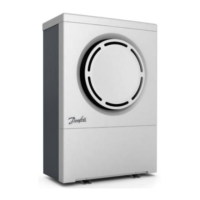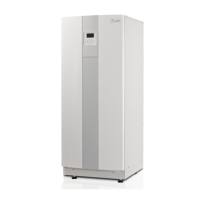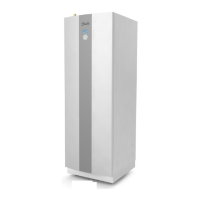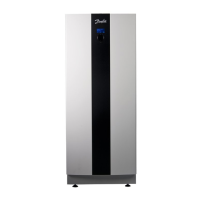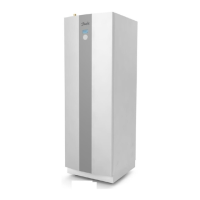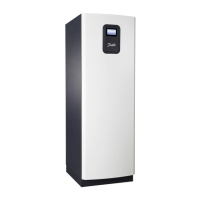Problem – Alarm HP (high pressure pressure switch)
Cause Troubleshooting Remedy
1. Blocked strainer in the heating system. Check that the strainer is not blocked. Clean the strainer if necessary.
2. Air in the heating system. Listen for air in the heat pump and heating
system.
Bleed the heating system circuit accord-
ing to the installation instructions.
3. Closed or partially closed thermostats/
valves in the heating system.
Check that the thermostats/valves in the heat-
ing system are open.
Open closed thermostats/valves.
4. The circulation pump that is defective or
has jammed.
Is there voltage to the circulation pump? In the control computer’s manual test
menu check that the circulation pump
is active.
Check if there is voltage to the circula-
tion pump, if there is, and it does not
run, the circulation pump is jammed.
If this is the case, open the bleed
screw and try to release the paddle
wheel using a screwdriver for example
(Does not apply to heat pumps in the
Optimum series).
If there is no voltage to the circulation
pump, check if there is voltage from the
control computer, see wiring diagram. If
there is voltage from the control compu-
ter, check the components between the
control computer and circulation pump.
If a component is defective, replace it.
5. Shut-off main tap in heating system. Check that the main tap is open. Open closed main tap.
6. Cable break or loose cable to high pres-
sure pressure switch.
•Checkthatbothcablesareconnectedonthe
pressure switch.
•Usingthebuzzer,checkthatthereareno
cable breaks. In order to do this, disconnect
the cables from the pressure switch and circuit
board.
If a cable has come loose, connect it.
If there is a cable break, replace the
cable.
7. The operating pressure switch does not
open.
•Incorrectpressureswitchinstalled.Sameor
higher break pressure than high pressure pres-
sure switch. See marking.
•Pressureswitchfault,opensatahigherpres-
sure than indicated (mark pressure). Check
using the manometer apparatus.
•Defectivepressureswitch,neveropens.
If the operating pressure switch does
not open, replace it.
8. The high pressure pressure switch opens
too soon.
•Incorrectpressureswitchinstalled.Aslowor
lower break pressure than operating pressure
switch. See marking.
•Pressureswitchfault,opensatalowerpres-
sure than indicated (mark pressure). Check
using the manometer apparatus.
•Defectivepressureswitch,alwaysopen.
If the high pressure pressure switch
opens too soon or is always open,
replace it.
9. External system shunt that closes on time
setting.
Check for shunts or valves in the system, which
are timer-controlled, that close down the entire
or too large a part of the heating system.
Always ensure that there is a sufficiently
large water volume for the heat pump
to work against, i.e. for the heat to give
off its heat to.
10. Incorrectly facing non-return valve with
too high opening pressure.
•Checkthesystem’sdirectionofflowandthat
the non-return valve is turned the correct way.
•Checkthattheheatpump’sexternalavailable
pressure exceeds the non-return valve’s open-
ing pressure.
If the non-return valve is facing the
wrong way, turn it.
If the non-return valve has too great an
opening pressure, replace it.
11. Large pressure drop in the heating sys-
tem.
•Dirtintheheatingsystem.
•Closedorpartiallyclosedthermostats/valves
in the heating system.
•Underdimensionedpipesystem.Checkthat
the HP’s external available pressure exceeds the
system pressure drop.
If necessary, clean/flush the heating
system.
Open closed thermostats/valves.
If there is not sufficient pressure equip-
ment, the heating system can be adjust-
ed according to the system solution for
large pressure drop.
